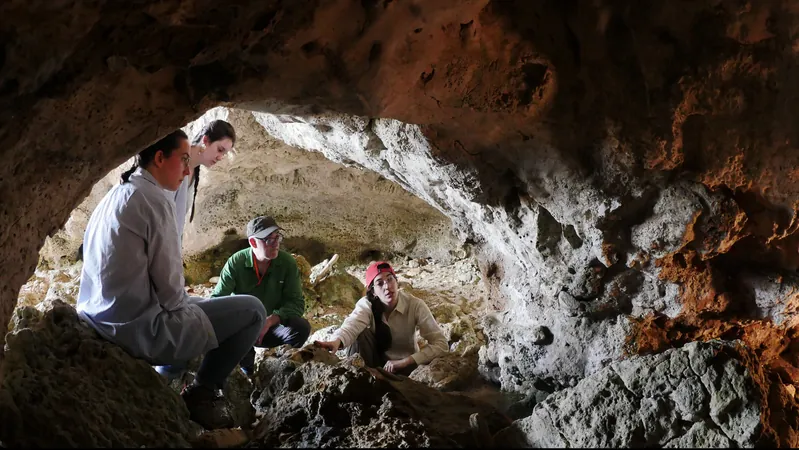
Unveiling the Secrets of Sicily: Underwater Caves Hold Key to Early Human Migration
2024-10-09
Author: Noah
Recent archaeological research led by experts at Washington University in St. Louis has uncovered significant findings in coastal and underwater caves along the southern shores of Sicily. This groundbreaking study offers invaluable insights into how early Homo sapiens expanded into Mediterranean islands and could rewrite our understanding of prehistoric human migration.
A detailed investigation published in the journal PLOS ONE assesses the archaeological contents of 25 caves and rock shelters, many of which had been forgotten since their discovery between the late 19th century and the 1990s. The research team undertook fresh land and underwater explorations in previously unexamined coastal regions, revealing three new sites that promise to contain critical archaeological sediments.
“What we seek to understand is not merely the arrival of the first individual but rather the formation of the first community,” stated Ilaria Patania, an archaeology assistant professor. “By determining when humans first colonized Sicily, we gain essential information about the broader patterns of early Homo sapiens expansion into the Mediterranean.”
Scholars widely regard Sicily as the first Mediterranean island to be permanently occupied by human ancestors; however, the timeline and methods of that initial migration remain elusive. With Sicily just under two miles from the Italian mainland, the challenge of crossing the strait would have posed significant dangers for early humans.
Although earlier studies had primarily focused on Sicily’s northern entry points, the current research opens up new possibilities. “This study illustrates how innovative thinking and methodologies can unveil historical patterns that were previously obscured,” remarked T.R. Kidder, a co-author of the study and anthropology professor.
Dangerous Waters: The Struggle for Survival
The Strait of Sicily, famous in literature and history for its treacherous waters, is not just a hazard for ancient seafarers; it remains perilous for modern day migrants. Each year, countless individuals risk their lives attempting to cross the strait in search of a better life, often facing life-threatening challenges.
Patania, deeply connected to her Sicilian roots, shares this respect for the sea, shaped by her family's history in fishing. “The sea is both a resource and a formidable adversary,” she notes. “Understanding how humans interact with these challenging environments is crucial, particularly as changing climates and other factors pose new threats.”
Scholars agree that humans reached Sicily approximately 16,000 years post the last glacial maximum. This date raises questions, as humans had previously migrated into other areas, such as Siberia, about 30,000 years earlier. The gap in timelines leads researchers to speculate that early human settlers may have arrived on Sicily far earlier than the established records suggest.
The precise route they took also remains unknown. Did they traverse the straits from Italy? Journey down from the African coast? Or island-hop their way across the Mediterranean? By identifying southern coastal sites, researchers hope to unravel these mysteries.
The Search for Answers Continues
Patania leads an ongoing research initiative aimed at uncovering more about early human habitation in Sicily. “To date, we have identified over 40 sites of interest, refining our knowledge of approximately 17 previously recorded locations,” she shared.
The multi-disciplinary approach to their research included delving into local archives, speaking with past excavators, and collaborating with local divers and fishermen. For instance, a retired tugboat operator, lacking formal scientific training but deeply familiar with the region’s waters, provided critical insights for locating potential sites.
The collaboration also extends to local government and military experts to refine underwater exploration techniques. Italian Navy divers, being trained to identify archaeological features in local waters, will play a vital role as the project expands further offshore.
Promising Discoveries
Initial findings from two new sites in the PLOS ONE study indicate possible traces of Upper Paleolithic human presence. One notable location, Corruggi, situated at Sicily's southernmost tip, was first documented in the 1940s and may have once been connected to Malta by a land bridge.
Patania noted, “At this site, we have uncovered European wild ass teeth and stone tools, which could illuminate the final stages of human migration towards Malta.”
Moreover, excavations at another cave named Campolato are currently ongoing. Here, the team aims to analyze evidence of ancient sea-level fluctuations and seismic activity, seeking to understand the living conditions of early human settlers and their adaptive strategies in response to natural calamities.
As this groundbreaking research unfolds, it promises to enhance our comprehension of early human life and migration patterns in a remarkably transformative era. Stay tuned as we continue to follow this exciting journey into Sicily's archaeological past, unlocking the secrets of our ancient ancestors!









 Brasil (PT)
Brasil (PT)
 Canada (EN)
Canada (EN)
 Chile (ES)
Chile (ES)
 España (ES)
España (ES)
 France (FR)
France (FR)
 Hong Kong (EN)
Hong Kong (EN)
 Italia (IT)
Italia (IT)
 日本 (JA)
日本 (JA)
 Magyarország (HU)
Magyarország (HU)
 Norge (NO)
Norge (NO)
 Polska (PL)
Polska (PL)
 Schweiz (DE)
Schweiz (DE)
 Singapore (EN)
Singapore (EN)
 Sverige (SV)
Sverige (SV)
 Suomi (FI)
Suomi (FI)
 Türkiye (TR)
Türkiye (TR)